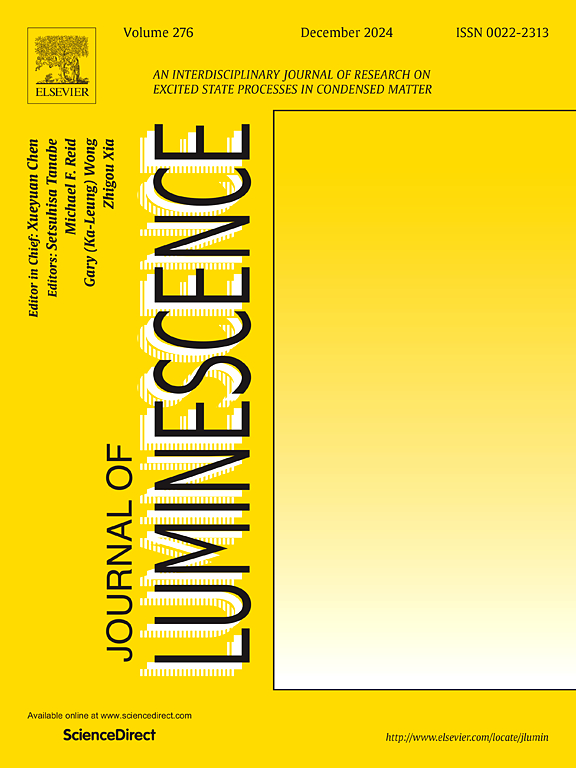Machine learning-based predictions of the 4fn-4fn-15d1 UV absorption for Pr3+ and Ce3+ ions in fluoride and oxide compounds
IF 3.3
3区 物理与天体物理
Q2 OPTICS
引用次数: 0
Abstract
The development of UV-C (100–280 nm) emitting phosphors utilizing the upconverted 4fn-15 d1→4fn interconfigurational broad band emission transition of lanthanide ions requires the fundamental understanding of the host-impurity interaction, which determines the positions of energy levels of the 4fn-15 d1 electronic configuration. In this work, we developed an ML Random Forest–based prediction algorithm utilizing a set of 22 dataset descriptors, such as structural characteristics of the host materials, electronic band gaps, ionic radii, and other material properties. The model was successfully tested across 46 impurity centers in various fluoride (chloride) and oxide compounds doped with the Pr3+ or Ce3+ ions. As an outcome of the developed model, predictions of the 4f-5d absorption wavelengths of Pr3+ and Ce3+ ions in the investigated hosts, were generated, demonstrating good correlation with the available literature data used initially for training. The obtained results indicate that host materials characterized by (i) a higher polyhedral volume (defined as the volume of the polyhedron formed by the impurity ion and its nearest neighbors), (ii) a higher coordination number (8 or 9), and (iii) high anion electronegativity—particularly fluorides doped with Pr3+ and Ce3+—may be of interest for applications in the UV-C domain. The resulting prediction model is characterized by the mean absolute errors between the predicted and literature data on the absorption wavelength of less than 3 nm only, which confirms the model's robust and effective performance. The approach developed in this work can be readily extended to other families of materials and/or dopant ions.

基于机器学习的氟化物和氧化物中Pr3+和Ce3+离子的4fn-4fn-15d1紫外线吸收预测
利用镧系离子上转换4fn- 15d1→4fn构型间宽带发射跃迁,开发UV-C (100-280 nm)发光荧光粉,需要对主杂质相互作用的基本理解,这决定了4fn- 15d1电子构型的能级位置。在这项工作中,我们开发了一种基于ML随机森林的预测算法,利用一组22个数据集描述符,如主体材料的结构特征、电子带隙、离子半径和其他材料特性。该模型成功地在掺杂Pr3+或Ce3+离子的各种氟化物(氯化物)和氧化物化合物的46个杂质中心进行了测试。根据所建立的模型,预测了所研究宿主体内Pr3+和Ce3+离子的4f-5d吸收波长,与最初用于训练的现有文献数据具有良好的相关性。所得结果表明,具有(i)较高多面体体积(定义为杂质离子及其最近邻居形成的多面体的体积),(ii)较高配位数(8或9)和(iii)阴离子电负性高的主体材料-特别是掺杂Pr3+和Ce3+的氟化物-可能对UV-C领域的应用感兴趣。所得预测模型仅在吸收波长小于3 nm的范围内与文献数据存在平均绝对误差,验证了模型的鲁棒性和有效性。在这项工作中开发的方法可以很容易地扩展到其他家族的材料和/或掺杂离子。
本文章由计算机程序翻译,如有差异,请以英文原文为准。
求助全文
约1分钟内获得全文
求助全文
来源期刊

Journal of Luminescence
物理-光学
CiteScore
6.70
自引率
13.90%
发文量
850
审稿时长
3.8 months
期刊介绍:
The purpose of the Journal of Luminescence is to provide a means of communication between scientists in different disciplines who share a common interest in the electronic excited states of molecular, ionic and covalent systems, whether crystalline, amorphous, or liquid.
We invite original papers and reviews on such subjects as: exciton and polariton dynamics, dynamics of localized excited states, energy and charge transport in ordered and disordered systems, radiative and non-radiative recombination, relaxation processes, vibronic interactions in electronic excited states, photochemistry in condensed systems, excited state resonance, double resonance, spin dynamics, selective excitation spectroscopy, hole burning, coherent processes in excited states, (e.g. coherent optical transients, photon echoes, transient gratings), multiphoton processes, optical bistability, photochromism, and new techniques for the study of excited states. This list is not intended to be exhaustive. Papers in the traditional areas of optical spectroscopy (absorption, MCD, luminescence, Raman scattering) are welcome. Papers on applications (phosphors, scintillators, electro- and cathodo-luminescence, radiography, bioimaging, solar energy, energy conversion, etc.) are also welcome if they present results of scientific, rather than only technological interest. However, papers containing purely theoretical results, not related to phenomena in the excited states, as well as papers using luminescence spectroscopy to perform routine analytical chemistry or biochemistry procedures, are outside the scope of the journal. Some exceptions will be possible at the discretion of the editors.
 求助内容:
求助内容: 应助结果提醒方式:
应助结果提醒方式:


